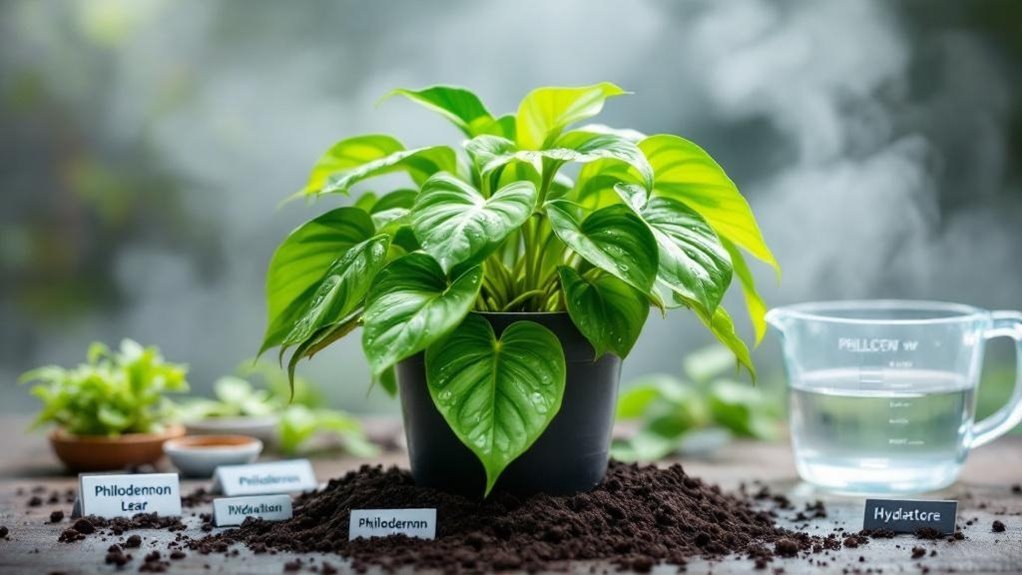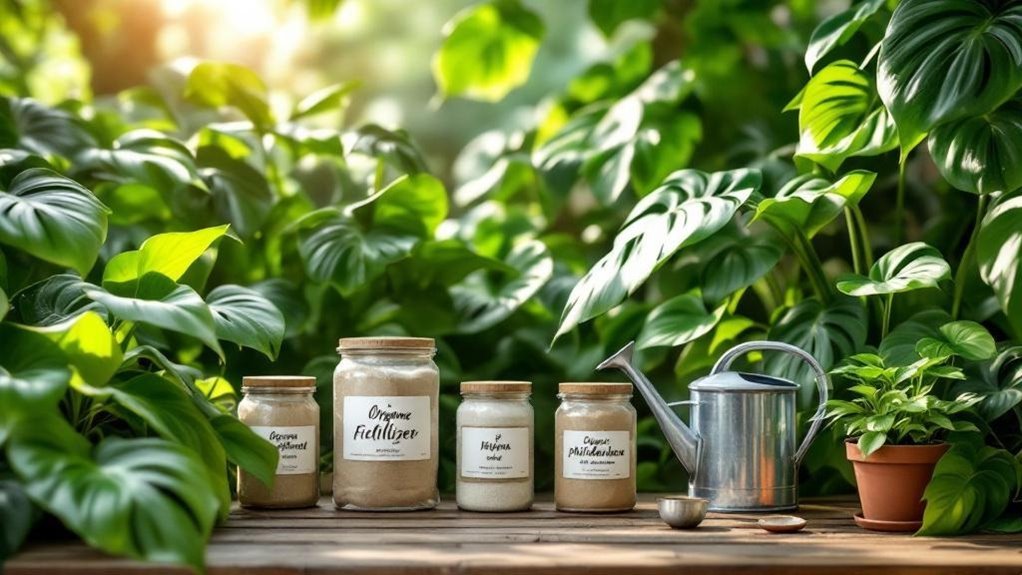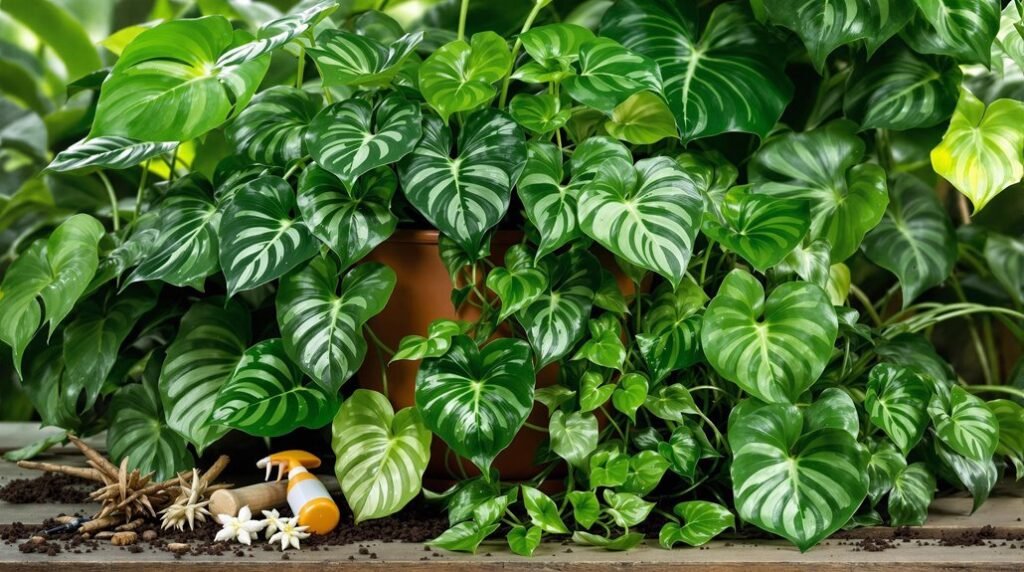If you’re looking to keep your philodendrons healthy and thriving, understanding their unique needs is essential. Different varieties require specific light, water, and soil conditions to flourish. Whether you’re caring for a climbing type or a bushy one, getting these basics right will make all the difference. Before you adjust your routine, there are some important factors you’ll want to take into account to guarantee your plants don’t just survive but truly thrive.
Philodendron Varieties and Their Characteristics
Philodendrons come in a variety of forms, from vining types like P. erubescens that need support to upright growers such as P. bipinnatifidum.
When exploring Philodendron varieties, you’ll notice distinct characteristics that set each apart. The heartleaf philodendron charms with its simple, heart-shaped leaves and adaptability to low-light spots.
Heartleaf philodendron delights with its classic heart-shaped leaves and thrives even in low-light spaces.
If you want colorful foliage, the Pink Princess offers stunning variegation, while the Birkin philodendron impresses with white-striped dark green leaves.
The Split-Leaf Philodendron stands out for its large, deeply lobed leaves, adding drama to any room.
Rojo Congo features bold red and green foliage, perfect for those who like vibrant hues.
Whether you prefer vining varieties or non-climbing types, Philodendrons provide diverse shapes and colors to suit your indoor garden.
Optimal Light Conditions for Philodendrons
Although these plants can tolerate a range of lighting, providing bright, indirect light for at least five hours a day will help your philodendron thrive and maintain vibrant foliage.
Variegated varieties need more bright light to enhance their colors, while dark green types adapt well to medium light. Avoid direct sunlight, especially afternoon rays, to prevent leaf burn.
Place your philodendron near eastern or northern-facing windows or a few feet from sunny windows to guarantee gentle indirect light. Insufficient light often leads to yellowing leaves, slower growth, and smaller leaves.
Regularly adjust light conditions based on your philodendron’s foliage type to encourage ideal growth. By managing these light conditions carefully, you’ll keep your philodendron healthy, colorful, and flourishing.
Soil Composition and Watering Best Practices

Choosing the right soil and watering routine can make all the difference in helping your philodendron flourish.
Start with a soil composition that features a well-draining potting mix rich in organic matter to support healthy growth. Confirm your pot has drainage to prevent waterlogging, which can lead to root rot.
Follow a watering schedule by checking if the top inch of soil is dry before you water the plant, usually every one to two weeks. Use room temperature water to avoid shocking the roots.
Periodically flush the soil with thorough watering to improve nutrient absorption and prevent salt buildup.
While soil and watering are key, maintaining proper humidity levels will further enhance your philodendron’s health and vibrant appearance.
Temperature and Humidity Requirements
When you keep your philodendron in temperatures between 65°F and 85°F (18°C to 29°C), it thrives best and stays healthy.
Avoid exposing it to temperatures below 55°F (13°C), as cold can cause stress and leaf drop.
This plant prefers a warm, humid environment with humidity levels from 40% to 60% to support peak growth.
Low humidity often results in brown leaf tips and edges, signaling that your plant needs more moisture in the air.
To maintain proper humidity, use a humidifier, pebble trays, or mist the leaves regularly.
Sudden temperature changes or cold drafts can disrupt your philodendron’s care routine and negatively affect its growth.
Keeping a consistent temperature and humidity level creates the ideal environment for your plant’s health and well-being.
Fertilizing and Nutrient Management

Maintaining the right temperature and humidity sets the stage for your philodendron’s overall health, but feeding it properly keeps it growing strong and vibrant.
During the growing season, fertilize monthly with a balanced liquid fertilizer rich in nitrogen to encourage fast growth and lush leaf growth. In fall and winter, reduce fertilizing to every six to eight weeks as growth slows.
Watch for pale or stunted new leaves—they may signal a need for a nutrient boost with calcium or magnesium supplements. Always stick to the recommended dosage to avoid over-fertilization, which can damage your plant. Additionally, using a fertilizer with a balanced NPK ratio like 10-10-10 can provide comprehensive nourishment for your philodendron.
Pruning Techniques and Propagation Methods
Although pruning may seem intimidating at first, it’s essential for keeping your philodendron healthy and attractive. Use sterilized shears to remove dead or yellowing leaves, ideally in spring or summer. Always cut just above a leaf node to encourage new growth.
Light trimming can be done year-round to maintain shape and meet care requirements. For propagation, take 6-inch stem cuttings with at least one leaf. Place these cuttings in water, changing it every few days, or directly in potting mix until roots develop.
When repotting, you can divide larger plants by separating the root ball, creating new healthy plants. These pruning and propagation techniques not only rejuvenate your philodendron but also help you expand your collection effectively.
Identifying and Managing Common Pests and Diseases
Because philodendrons are prone to pests like aphids, mealybugs, and spider mites, you should regularly check the undersides of leaves for signs of infestation.
These pests cause leaf damage and can stunt growth if untreated. Use a water and mild dish soap mixture to control infestations effectively.
Yellowing leaves often signal overwatering, pest problems, or insufficient light, while rapid yellowing might indicate root rot or severe pest damage.
To prevent disease like dasheen mosaic, control aphid populations and sanitize your tools.
Maintaining proper humidity levels and cleaning leaves frequently also helps reduce pest outbreaks and disease risks.
Frequently Asked Questions
What Is the Holy Grail of Philodendrons?
You’re looking at the Holy Grail of Philodendrons, known as the Pink Princess. It’s famous for its dark green leaves with vibrant pink variegation, requiring bright, indirect light and consistent care to keep it thriving.
Do All Philodendrons Need the Same Care?
You wouldn’t treat every book the same, right? Philodendrons differ too—some crave more light, others need frequent watering or humidity. You’ll tailor care to each variety’s unique rhythm for them to truly thrive.
Should I Cut off Brown Leaves on Philodendron?
Yes, you should cut off brown leaves to help your philodendron focus energy on healthy growth. Use sterilized shears, cut just above a node, and check watering and humidity to prevent future browning.
Do Philodendrons Need Sun or Shade?
You might think Philodendrons need full sun, but they actually thrive in bright, indirect light. Avoid direct sunlight—it burns leaves. Too little light slows growth, so find a cozy spot near a window with filtered rays.
Final Thoughts
You might think caring for a Philodendron is as simple as forgetting it exists—but trust me, these plants have higher standards. Give them bright, indirect light, proper watering, and a little love, and they’ll reward you with lush, vibrant leaves. Ignore their needs, and you’ll quickly discover they’re not just low-maintenance couch potatoes. So, roll up your sleeves—you’re not just growing plants, you’re joining a leafy adventure that thrives on your attention.
